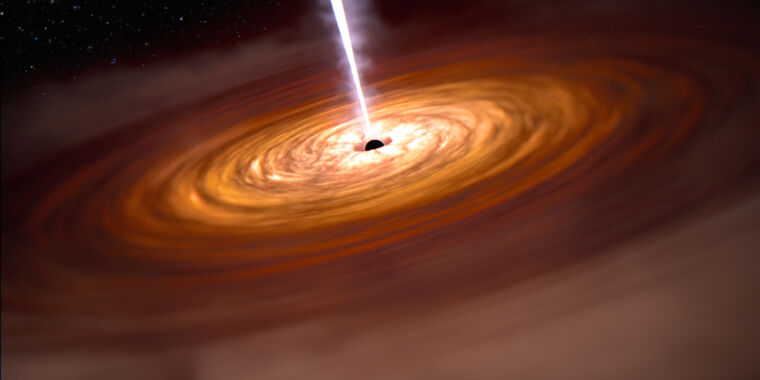Supermassive black holes appear to be present at the center of every galaxy, going back to some of the earliest galaxies in the Universe. And we have no idea how they got there. It shouldn’t be possible for them to grow from supernova remnants to supermassive sizes as quickly as they do. And we’re not aware of any other mechanism that could form something big enough that extreme growth wouldn’t be necessary.
The seeming impossibility of supermassive black holes in the early Universe was already a bit of a problem; the James Webb Space Telescope has only made it worse by finding ever-earlier instances of galaxies with supermassive black holes. In the latest example, researchers have used the Webb to characterize a quasar powered by a supermassive black hole as it existed approximately 750 million years after the Big Bang. And it looks shockingly normal.
Looking back in time
Quasars are the brightest objects in the Universe, powered by actively feeding supermassive black holes. The galaxy surrounding them feeds them enough material that they form bright accretion disks and powerful jets, both of which emit copious amounts of radiation. They’re often partly shrouded in dust, which glows from absorbing some of the energy emitted by the black hole. These quasars emit so much radiation that they ultimately drive some of the nearby material out of the galaxy entirely.
So, the presence of these features in the early Universe would tell us that supermassive black holes were not only present in the early Universe but were also integrated into galaxies as they are in more recent times. But it has been very tough to study them. For starters, we’ve not identified many; there are only nine quasars that date from before when the Universe was 800 million years old. Due to that distance, features are hard to resolve, and the redshift caused by the Universe’s expansion takes the intense UV radiation from many elements and stretches them deep into the infrared.
However, the Webb telescope was designed specifically to detect objects in the early Universe by being sensitive to the infrared wavelengths where this radiation shows up. So, the new research is based on pointing the Webb at the first of those nine early quasars to have been discovered, J1120+0641.
And it looks … remarkably normal. Or at least a lot like quasars from more recent periods in the Universe’s history.
Mostly normal
The researchers analyze the continuum of radiation produced by the quasar, and find clear indications that it is embedded in a hot, dusty donut of material, as is seen in later quasars. This dust is slightly hotter than in some more recent quasars, but that seems to be a common feature of these objects at earlier stages in the Universe’s history. Radiation from an accretion disk is also apparent in the spectrum of emissions.
Various means of estimating the black hole’s mass-produced values in the area of 109 times the mass of the Sun, placing it clearly in supermassive black hole territory. There’s also evidence, from a slight blueshift in some of the radiation, that the quasar is blasting material away at about 350 kilometers a second.
There are a couple of oddities. One is that the material also appears to be falling inward at about 300 kilometers a second. This could be caused by material rotating away from us in the accretion disk. But if so, it should be matched by material rotating toward us on the opposite side of the disc. This has been seen a few other times in very early quasars, but the researchers concede that “The physical origin of this effect is unknown.”
One option they suggest as an explanation is that the entire quasar is moving, rattled out of its position at the galaxy’s center by an earlier merger with another supermassive black hole.
The other oddity is that there’s also a very fast outflow of highly ionized carbon—moving at roughly twice the speed as it does in quasars at later times. This has been seen before, but there’s no explanation for it, either.
How did this happen?
Despite the oddities, this object looks a lot like quasars in more recent times: “Our observations demonstrate that the complex structures of the dusty torus and the [accretion disk] can establish themselves around a [supermassive black hole] less than 760 Myr after the Big Bang.”
And again, that’s a bit of a problem since it indicates the presence of a supermassive black hole integrated into its host galaxy very early on in the Universe’s history. To get to the sort of sizes seen here, black holes push up against what’s called the Eddington limit—the amount of material they can draw in before the radiation produced by doing so drives off neighboring material, choking off the black hole’s food supply.
That suggests two options. One is that these things ingested material far beyond the Eddington limit for most of their history—something we’ve not observed and something that’s definitely not true of this quasar. The other option is that they started out massive (at about 104 times the mass of the Sun) and kept feeding at a more reasonable rate. But we don’t really know how something that big can form.
So, the early Universe remains a fairly perplexing place.
Nature Astronomy, 2024. DOI: 10.1038/s41550-024-02273-0 (About DOIs).

Dr. Thomas Hughes is a UK-based scientist and science communicator who makes complex topics accessible to readers. His articles explore breakthroughs in various scientific disciplines, from space exploration to cutting-edge research.








